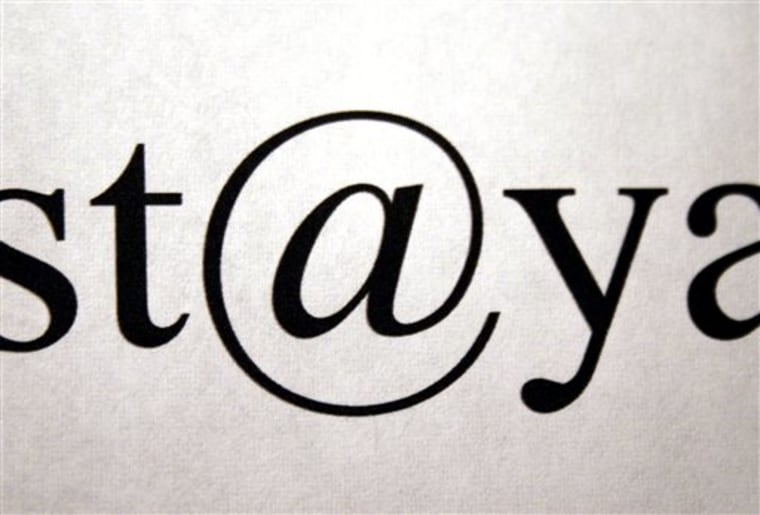The squiggly little "at" symbol that makes our e-mail go is more colorful in translation.
It's an elephant's trunk in Sweden. A monkey in Serbia — and a more, ahem, delicate part of the monkey in Holland. It's a snail in Korea, a little mouse in Taiwan.
In any language, it's come a long way since it was plucked from obscurity by e-mail godfather Ray Tomlinson back in computer-heady 1971. At the time, the character was used almost exclusively by grocers and accountants.
Its use made good sense to an English speaker, shifting definitions from a rate or amount of something to a location.
"It's the only preposition on the keyboard," Tomlinson said from Cambridge, Massachusetts, where he works as he has for decades at Raytheon BBN Technologies.
Didn't translate for others
But the connection was lost in other languages, and more visual references to food, animals and body parts sprang up, many based on the at's swirling shape. The symbol is still so unfamiliar that some newspaper and Web systems can't print it in this story.
"It's sort of like a Rorschach test. The language would sort of see in the at sign something notable from the culture. What people are familiar with is just so varied, so all these crazy things came out of it," said Karen Steffen Chung, an associate professor of linguistics, English and phonetics at National Taiwan University in Taipei.
The symbol is a strudel in Israel and a "rollmop" — for rolled pickled herring fillet — in Czech. It's "sobachka" for doggie in Russian, was dubbed an "alpha curl" in Norway and sometimes goes by "kanelbulle," a type of traditional cinnamon bun, in Swedish.
Sweden can't seem to make up its mind with the longest list of monikers, including elephant's trunk, elephant's ear, monkey's tail, cat foot, cat's tail and pretzel.
Serbs have variety of terms
Chung was so intrigued that she reached out to fellow linguists around the world in (what else) e-mail for their insights.
Among the things she discovered was a variety of terms in Serbian. The word "majmun" is one. It means monkey, appears to have been borrowed from Turkish and was used in "majmunski rep" (monkey tail) and "majmunsko-a" (monkey-ish a). The Serbs also invented "ludo-a" (crazy a) for the symbol none of us can escape.
Some countries have "official" terms for the "at." The Swedish Language Board deemed it "snabel-a" (trunk-a), meaning "a" with an elephant's trunk. Elsewhere, English prevails, including in Finland, South Africa and India.
The spin on "at" in Holland is English, too, but "apeklootje" (little monkey's testicle) was once in play during the sign's rapid rise to stardom. In Sri Lanka, the government agency responsible for promoting information technology on the island nation has no specific word for the symbol in Sinhala, referring to it simply as the "at symbol."
Local pronunciations of the English where other languages dominate include "et" for "a" in Serbian and "ah-te" (think Ted without the d) in mainland China. Mandarin Chinese hasn't come up with a character for the revolutionary sign.
Japanese, known for borrowing from other languages with a distinctive local pronunciation, usually go for "atto maaku," meaning the English "at," while Greek turned the squiggle into a "little duck" and Hungarian a "little worm."

Arab speakers sometimes translate the English "at" to its equivalent, "fi," though others see it as an "ear" instead when providing their e-mail addresses.
In Taiwan, where Chung lives, the local meaning is "little mouse," a lot livelier than Korean's snail. The preferred word in Spanish is "arroba," which is also a unit of weight, though in Spain "at" can transform into a swirly pastry from Majorca, "ensaimada."
To some in Latin America, the "at" has grown linguistic muscle to stand in as a gender-neutral indication of both male and female (nin(at)s means you're talking about both ninos and ninas.
Slovenian speakers prefer "afna," possibly borrowed from German, where the at is called, among other things, "affenschwanz" (monkey's tail). A similar word in Slovenian means "a woman who overdresses, applies too much makeup etc.," Chung learned.
Originally for ARAPNET
Tomlinson didn't have the world's many "ats" on his mind when he developed his e-mail protocol using a nearly forgotten key on a Model 33 Teletype machine for use on ARPANET, one of the networks that became the global Internet.
It was Tomlinson who decided to append the "at" sign and the host name to a user's login identity. Not only did it make sense as a preposition, but it was unlikely to be confused for any other part of a user's e-mail address, a term that hadn't yet surfaced.
The succinctness of the at sign, he thinks, played into the imagery in other languages.
"They certainly all tend to be taking something that's more familiar than some dry piece of commercial signage," Tomlinson said. "It's a simple symbol and it's been adopted and sort of been made into a fan icon for anything to do with computers."
The Museum of Modern Art is a fan. It "acquired" the symbol for its collection earlier this year.
At 69, the low-key Tomlinson is still working as a programmer on projects unrelated to e-mail. Have his two grown daughters made full use of bragging rights over dad's e-mail claim to fame?
"They try to be cooler than that," Tomlinson said.
